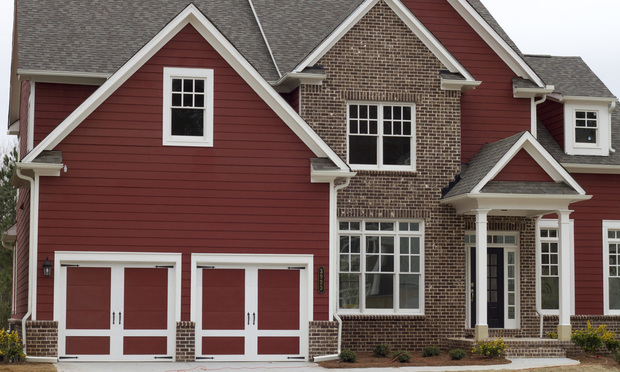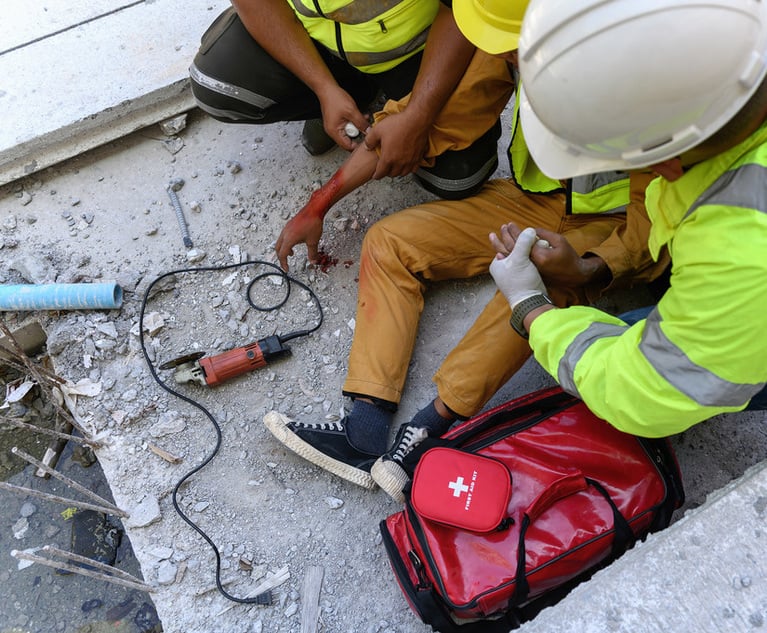The NJ New Homeowner Warranty: An Owner's Friend or Foe?
The New Jersey HOW presents a case of good intentions gone awry; the Act's arbitration provisions sacrifice an aggrieved homeowners' day in court.
April 18, 2019 at 02:00 PM
9 minute read
 John Disney/ ALM
John Disney/ ALM
When the New Jersey New Home Warranty and Builder's Registration Act (HOW), administered under the Department of Community Affairs (DCA), was passed in 1977, it was hailed as revolutionary. The Act presented an innovative way to assist buyers of new residential construction struggling with construction defects plaguing many areas of the country, including New Jersey and Pennsylvania. After kicking the tires of the legislation over several years, attorneys and architects are learning that the Act is not the cure-all remedy once thought. Through our day-to-day practices, we have uncovered fundamental unfairness in the HOW program.
What's in the HOW warranty?
HOW provides warranty recourse for a homebuyer for up to 10 years, with decreasing limits of coverage during the policy term. During the first year, the program provides that the dwelling shall be free from defects caused by faulty workmanship, defective materials, and noncompliance with building standards. In the second year, the program provides warranty coverage for systems related defects, such as faulty installation of plumbing, electrical, and heating and cooling systems. Yet, in years 3-10 of the program, the warranty coverage extends only to “major construction defects,” as defined by the regulations governing the Act. This is commonly referred to as a 2-10 policy.
Specifically, the regulations define “major construction defects,” in relevant part:
The load bearing portion of a home is defined as the framing members and structural elements that transmit both dead and live loads of the home to the supporting ground. Examples of load bearing elements are: roof rafters and trusses; ceiling and floor joists, bearing partitions; supporting beams; columns; based foundation walls and footings.
[T]he loading portion of a home is further designated by the new home warranty program to be limited to only major structural elements. A major structural element is one that if damaged due to a defect can cause progressive or general collapse of the structural system of the home.
In practice, we have observed that any claims made during years 3-10 are generally not honored, or found to trigger warranty protections, unless the residence is currently, when observed by a HOW inspector, in a full state of active collapse.
Private warranties offer better resolution success rates
Given the high bar the Act places on recovering in years 3-10, the success rates of the entity administering the warranty should be high. The typical New Jersey homebuyer does not know that they can obtain a warranty through a private company. This is important because different providers offer different success rates and more transparency. Usually, a homebuyer accepts the transferred policy from the new home builder not realizing that there are six other DCA approved private warranty providers. All private warranty providers offer the typical 2-10 policy. These private providers typically provide statistics on their claim resolution rates, many as high as 93-95%. This is critical information most homeowners are not getting.
Election of remedies or denial of due process?
The most onerous component of the HOW is the statutory “election of remedies” bar. This is a pitfall many homeowners face, and it's an issue impacting design and construction professionals as well. The election of remedies bar provides:
Nothing contained herein shall affect other rights and remedies available to the owner. The owner shall have the opportunity to pursue any remedy legally available to the owner. However, the initiation of procedures to enforce a remedy shall constitute an election which shall bar the owner from all other remedies. Nothing contained herein shall be deemed to limit the owner's right of appeal as applicable to the remedy elected.
This provision is usually not explained to a new homebuyer. Instead, the provision is buried deep in a homebuyer's warranty manual given to the homebuyer at closing. If a homebuyer makes a HOW warranty claim, a HOW claims analyst reviews the claim and generates a report. If the analyst reaches a determination that coverage is triggered under the warranty, then the defects are processed and fixed either by the builder/developer, or paid for by HOW, acting as a surety with a right of subrogation against the negligent party. For any claim made during years 3-0, the standard is very high—in general, requiring collapse. From a construction defect perspective, this is problematic because latent defects in new home construction do not manifest for several years. A homebuyer can find themselves stuck with a defective home in years 3-10 that would have otherwise received warranty coverage had the defects manifested in the first or second year. The idea that a home that is 3-5 years old needs to be structurally unsound in order seek relief seems fundamentally unfair.
Understandably, New Jersey homebuyers consider the warranty program to be the easiest and quickest path to resolution of their problems. Indeed, a speedy, streamlined, remedy was the legislative intent of HOW. However, when a claim is denied, many homebuyers go through the HOW arbitration process, often at the direction of their design or construction professional. When an aggrieved homeowner submits a claim to a HOW arbitrator that is denied, an outcome which is more likely if the claim takes place within the 3-10-year policy window, the homeowner reasonably wants to seek legal recourse in court. Once the arbitration process is selected, the election of remedies comes into play, effectively barring any homeowner claims raised during the HOW arbitration process in state or federal court.
This is where caveat emptor applies. The election of remedies clause forever bars homeowners from bringing their claims in state or federal court. In the situation described above, the only way for a complaint to survive the election of remedies bar is the identification of additional construction defects not submitted by the homeowner to the HOW arbitrator, which were not known or readily apparent at the time of the HOW arbitration process. These are the types of latent defects often revealed as the process of remediation is underway. Legal claims often become cost prohibitive, time consuming, and require additional analysis as to what defects were known and submitted to the HOW arbitrator, or were known or should have been known by the homeowner at the time of the arbitration.
Perhaps unintentionally, the HOW arbitration process strongly favors the builder/developer over the homeowner. When a HOW claim is submitted, the arbitrator must decide two issues: (1) do the construction defects rise to a level that would trigger warranty coverage; and (2) if warranty coverage is triggered, are the claims construction defects that are attributable to the builder, or are they defects attributable to unrelated causes, such as improper maintenance or shoddy repair work? If the arbitrator reaches a determination that the claims do not trigger coverage, the analysis ends there, and a denial is issued. The aggrieved homeowner is then forever barred from pursuing these claims in state or federal court.
Here, we see that the Act is lopsided. The HOW arbitration analysis is limited to whether there are construction defects, and whether or not the warranty affords coverage so those defects can be remedied. This process is limited to two parties: the homebuyer claimant and the builder/developer. No design professionals can be joined and therefore, a homeowner cannot bring claims for negligent design. Homeowners cannot bring any Consumer Fraud Act claims against the builder/developer. Homeowners cannot bring claims for general fraud, negligence, or misrepresentation claims. The homeowner cannot seek exemplary damages in the HOW arbitration process, yet, those very same claims are forever barred in state or federal court. This offends traditional notions of res judicata and collateral estoppel. If a HOW arbitrator never got beyond the initial threshold analysis of whether warranty coverage was triggered and never considered, or reached a decision on, the actual merits, i.e., if there were in fact construction defects attributable to the malfeasance of the builder, then the homebuyer's claim was never really heard. There should be no preclusive effect based upon res judicata or collateral estoppel.
How we can make HOW better
There are several fixes that readily come to mind when considering the HOW process. An improved mechanism for educating homebuyers about how the HOW program works would go a long way to protect homebuyers and homeowners. Specifically, homebuyers and homeowners should understand the high standard for coverage in years 3-10 and the election of remedies bar. These clauses should be spelled out in bold face print, no less than 14 size font. Homebuyers should be required to specifically initial these two provisions indicating they have read them and understand the terms. These two provisions of the Act pose the greatest risk to average homebuyers and homeowners, perhaps New Jersey real estate professionals should be asked to do more in this regard.
The other fixes are legislative in nature. Relaxing the 3-10 year regulations would afford homeowners more coverage. Preventing HOW claims analysts from approving claims during years 3-10 of the policy, unless the homeowner's roof is literally falling in on their head, defeats the legislative intent of the law. The election of remedies bar is simply bad law. It should be repealed, or restricted, to bar only those claims that are truly considered litigated within the context of the HOW arbitration process. Otherwise, developers that engage in faulty workmanship and fraudulent practices, can continue to escape being held liable for their actions solely because a homeowner does not understand how the Act operates. The New Jersey HOW presents a case of good intentions gone awry. For the sake of speed, the Act's arbitration provisions sacrifice an aggrieved homeowners' day in court. We can do better.
Lance S. Forbes is senior counsel with Horn Williamson in Philadelphia. He litigates routine and complex construction disputes. Mark Werther is a registered architect in Pennsylvania and New Jersey. In 1990, he formed Sentinel Consultation Services (SCS), which concentrates on forensics and, specifically, construction defects.
This content has been archived. It is available through our partners, LexisNexis® and Bloomberg Law.
To view this content, please continue to their sites.
Not a Lexis Subscriber?
Subscribe Now
Not a Bloomberg Law Subscriber?
Subscribe Now
NOT FOR REPRINT
© 2025 ALM Global, LLC, All Rights Reserved. Request academic re-use from www.copyright.com. All other uses, submit a request to [email protected]. For more information visit Asset & Logo Licensing.
You Might Like
View All

Dispute Resolution Boards—Getting Real Time Decisions on Construction Projects
7 minute read
Insurer Has No Duty to Defend 'Laidlow' Claims, NJ Supreme Court Says
3 minute read
Construction Worker Hit by Falling Concrete Settles Claims for $2.3M
4 minute readTrending Stories
- 1'A Death Sentence for TikTok'?: Litigators and Experts Weigh Impact of Potential Ban on Creators and Data Privacy
- 2Bribery Case Against Former Lt. Gov. Brian Benjamin Is Dropped
- 3‘Extremely Disturbing’: AI Firms Face Class Action by ‘Taskers’ Exposed to Traumatic Content
- 4State Appeals Court Revives BraunHagey Lawsuit Alleging $4.2M Unlawful Wire to China
- 5Invoking Trump, AG Bonta Reminds Lawyers of Duties to Noncitizens in Plea Dealing
Who Got The Work
J. Brugh Lower of Gibbons has entered an appearance for industrial equipment supplier Devco Corporation in a pending trademark infringement lawsuit. The suit, accusing the defendant of selling knock-off Graco products, was filed Dec. 18 in New Jersey District Court by Rivkin Radler on behalf of Graco Inc. and Graco Minnesota. The case, assigned to U.S. District Judge Zahid N. Quraishi, is 3:24-cv-11294, Graco Inc. et al v. Devco Corporation.
Who Got The Work
Rebecca Maller-Stein and Kent A. Yalowitz of Arnold & Porter Kaye Scholer have entered their appearances for Hanaco Venture Capital and its executives, Lior Prosor and David Frankel, in a pending securities lawsuit. The action, filed on Dec. 24 in New York Southern District Court by Zell, Aron & Co. on behalf of Goldeneye Advisors, accuses the defendants of negligently and fraudulently managing the plaintiff's $1 million investment. The case, assigned to U.S. District Judge Vernon S. Broderick, is 1:24-cv-09918, Goldeneye Advisors, LLC v. Hanaco Venture Capital, Ltd. et al.
Who Got The Work
Attorneys from A&O Shearman has stepped in as defense counsel for Toronto-Dominion Bank and other defendants in a pending securities class action. The suit, filed Dec. 11 in New York Southern District Court by Bleichmar Fonti & Auld, accuses the defendants of concealing the bank's 'pervasive' deficiencies in regards to its compliance with the Bank Secrecy Act and the quality of its anti-money laundering controls. The case, assigned to U.S. District Judge Arun Subramanian, is 1:24-cv-09445, Gonzalez v. The Toronto-Dominion Bank et al.
Who Got The Work
Crown Castle International, a Pennsylvania company providing shared communications infrastructure, has turned to Luke D. Wolf of Gordon Rees Scully Mansukhani to fend off a pending breach-of-contract lawsuit. The court action, filed Nov. 25 in Michigan Eastern District Court by Hooper Hathaway PC on behalf of The Town Residences LLC, accuses Crown Castle of failing to transfer approximately $30,000 in utility payments from T-Mobile in breach of a roof-top lease and assignment agreement. The case, assigned to U.S. District Judge Susan K. Declercq, is 2:24-cv-13131, The Town Residences LLC v. T-Mobile US, Inc. et al.
Who Got The Work
Wilfred P. Coronato and Daniel M. Schwartz of McCarter & English have stepped in as defense counsel to Electrolux Home Products Inc. in a pending product liability lawsuit. The court action, filed Nov. 26 in New York Eastern District Court by Poulos Lopiccolo PC and Nagel Rice LLP on behalf of David Stern, alleges that the defendant's refrigerators’ drawers and shelving repeatedly break and fall apart within months after purchase. The case, assigned to U.S. District Judge Joan M. Azrack, is 2:24-cv-08204, Stern v. Electrolux Home Products, Inc.
Featured Firms
Law Offices of Gary Martin Hays & Associates, P.C.
(470) 294-1674
Law Offices of Mark E. Salomone
(857) 444-6468
Smith & Hassler
(713) 739-1250






